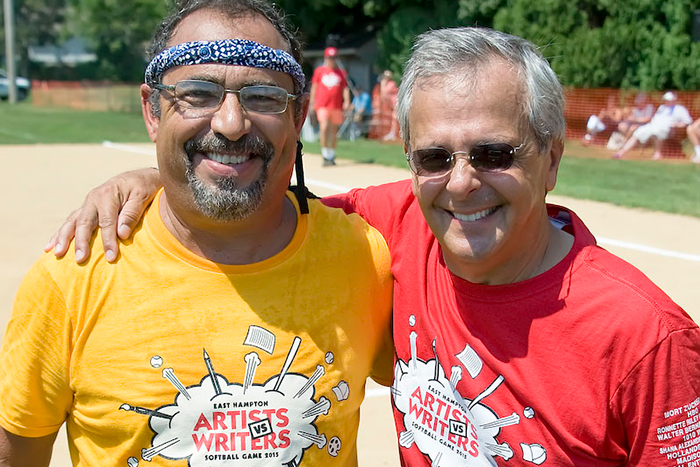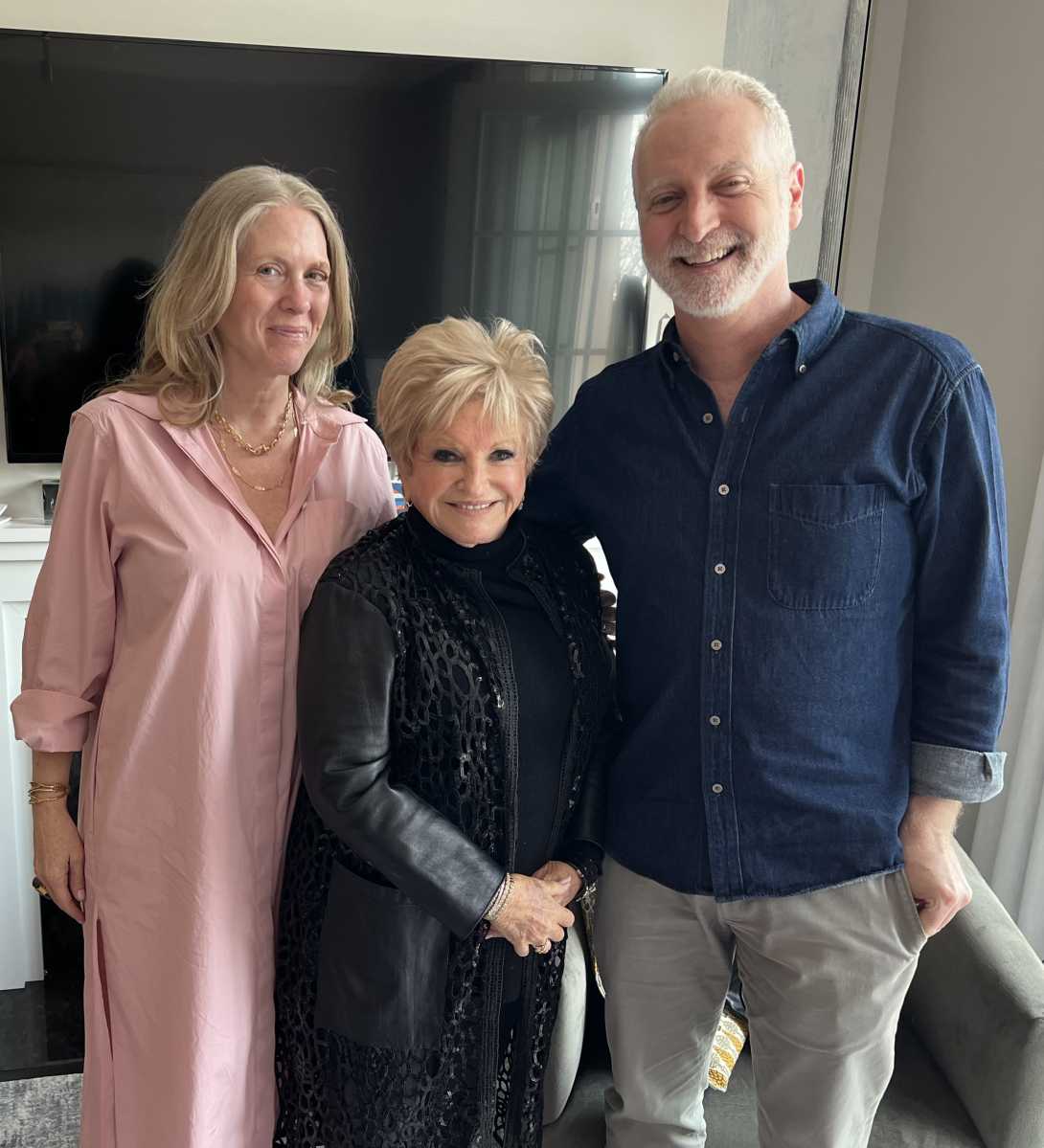Artist & Writers Charity Softball Game Reflection: Eric Ernst, Artist

East Hampton Artists & Writers Charity Softball Game veteran Eric Ernst, of the Artists team, shares memories from playing in this annual East Hampton event.
The head of NBC News lay sprawled in the dirt, his face a Kabuki mask of pain and confusion, his shoulder twisted and contorted at an unnatural angle while nearby, on first base, stood the former heavyweight boxer and one-time Great White Hope, whose head’s up hustle (and bone crushing collision) had won him an infield single.
Among the spectators, who had come to see celebrities like Paul Simon, Christie Brinkley or Regis Philbin, the initial response was a kind of shocked silence. Midst the startled hush while the television executive was carted off the field and taken to Southampton Hospital, I heard someone nearby ask, “What the hell was that? I thought this was a friendly game.”
A game made up of friends perhaps, but in the many years since I started watching the game as a child I’ve seen the textbook evolution of a competition that is, in the deluded minds of the players themselves, as intense and legitimate as the Red Sox against the Yankees, Muhammad Ali versus Joe Frazier, or the Celtics facing the Lakers. Motivated by the same explosively flammable combination of competitive drive and repetitive familiarity (absent, of course, any discernible athletic prowess), the Artist and Writers game illustrates with immediate clarity that victory is most satisfying when it’s over those one is most familiar with.
As I once thought I heard the noted author Ken Auletta intone, he whose graceful fielding at first base is so often accented by quotes from Louisa May Alcott, “Rivalry adds so much to the charm of one’s conquests.”
So when might this blood feud have actually begun? Some have maintained it started when the writers began showing up more regularly and insisted on playing by legitimate rules.
Up to that point the games were distinctly pick-up affairs where regulations were less important than libations and where the final score was often unknown to but a few who had actually paid attention.
All of a sudden, however, a premium was placed on actually knowing the intricacies of the game, subtleties often lost on artists like Willem deKooning, Esteban Vicente, or my father, Jimmy Ernst, all European émigrés all who loved American baseball but had been raised playing soccer.
As for the writers, each year always seemed to boast a dramatically better line-up than the year before with luminaries like George Plimpton elegantly patrolling center field like a WASP Joe DiMaggio, Neil Simon slinging wisecracks and cracking doubles over Larry Rivers’s head, or Jimmy Lipton, playing a scrappy second base like a cross between Dodger great Eddie Stanky and an angry badger.
Against this kind of line-up throughout my youth the artists never provided a serious contest so no true rivalry developed until Lief Hope expanded his role from artist manager to P. T. Barnum–like promoter on behalf of the various worthy causes the game serves to benefit.
The germination for the idea of raising money for charity began when the game was used to gather campaign funds for Eugene McCarthy (the only poet/Senator to ever run for President) and then a few years later to help defend artists Bob Gwathmey and Bill Durham in a landmark civil rights case which involved their arrest for flying a bath

towel painted to look like the American flag with a peace sign where the stars would be.
Having realized it was possible to raise funds for a candidate who couldn’t possibly win as well as helping to keep artists with a whimsical sense of political protest out of jail, an idea was born and Lief, while now seeing the altruistic possibilities the game presented, also recognized that in order to attract attention it would be necessary to promote the game in a whole new way.
As a result, his first promotion was fielding an all-girl team of artists and hiring a professional woman softball player to fire 90 mile per hour inside fastballs at the writers’ which, for some inexplicable reason, many of the scribes found distinctly unfunny. They didn’t find it entertaining when she pitched a scoreless first inning and they were even more demonstrably unhappy when she was brought back into the game to squelch a writer’s rally in the ninth. The artists ended up winning a game for the first time in modern memory and, among the writers, the manager of the artists had earned the lovable nickname “that son of a bitch Lief Hope.”
Over the years other professional athletes were to follow including Dale Berra, Wesley Walker, Pelé, and Marty Lyons (whose mammoth home run into the tennis courts is still spoken of in hushed tones), but it was the actual accumulation of talent on the artists’ team in the early 1990s that truly leveled the playing field. Admittedly, the definition of artist had expanded to include just about any profession that even remotely could be construed as “creative” but, at the same time, as soon as the game became competitive the meaning of “writer” also became significantly more elastic as well.
The artists would add a landscape architect which would be parried by an advertising executive who writes copy which was upped by a lawyer who has an artist for a client which was then offset by a real estate agent who once wrote a short story. And so on.
One wonders, then, what new manifestation of gamesmanship will be required for the two teams to remain competitive in the coming years, especially as the core players for each team inevitably must bow to the inevitable inroads of time. Already within the past few years, a number of incidents of the use of performance enhancing substances have been documented including an overdose of Red Bull (leading the overly energized and wide-eyed runner to forget that one can’t go from first to third by bisecting the diamond) and steroid use (actually a cortisone injection for a bad shoulder but, hey, it’s a steroid). Further, at least one storied member of the artist team has for years been a known aspirin and milk junkie.
It should be pointed out, however, that even absent these recent evolutionary trends towards more competent contests, the historical enmity between artists and writers will always guarantee a measure of personal animosity regardless of talent on either side. This has been true from the moment in 1456 when the Renaissance sculptor Donatello taped a ‘kick me’ sign to the back of author Leon Battista Alberti’s cloak, it was evident when heavyweight Gerry Cooney flattened NBC’s Andrew Lack, and it’ll be just as apparent this summer when sportswriter Mike Lupica has his annual collision at home plate with sculptor Randall Rosenthal.
Ernst will be back on the field for this year’s game on Saturday, August 20 at Herrick Park in East Hampton. Batting practice starts at noon and the first pitch goes out at 2 p.m.
Visit artistswritersgame.org for more info.



